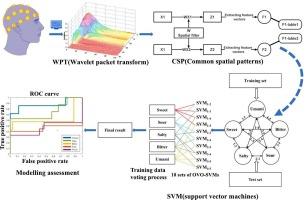当前位置:
X-MOL 学术
›
Food Chem.
›
论文详情
Our official English website, www.x-mol.net, welcomes your
feedback! (Note: you will need to create a separate account there.)
The influence of different flavor peptides on brain perception via scalp electroencephalogram and development of a taste model
Food Chemistry ( IF 8.5 ) Pub Date : 2024-11-14 , DOI: 10.1016/j.foodchem.2024.141953 Hongbo Li, Xuchao Feng, Zhenbin Liu, Wenting Wang, Lufei Tian, Dan Xu, Bimal Chitrakar, Zhenkun Cui, Liangbin Hu, Haizhen Mo
Food Chemistry ( IF 8.5 ) Pub Date : 2024-11-14 , DOI: 10.1016/j.foodchem.2024.141953 Hongbo Li, Xuchao Feng, Zhenbin Liu, Wenting Wang, Lufei Tian, Dan Xu, Bimal Chitrakar, Zhenkun Cui, Liangbin Hu, Haizhen Mo

|
Traditional taste evaluation methods often rely on subjective assessments, introducing biases. To address this, we propose using electroencephalography (EEG) to explore the link between brain activity and taste perception. Our EEG analysis showed significant activity differences in specific brain regions, particularly at electrodes Pz, FT7, F7, and TP7, highlighting their role in taste signal processing. Consistent activity at Pz across various tastes supports the development of a mathematical model and sensory evaluation system. We used wavelet packet transform for EEG signal preprocessing, followed by feature extraction and classification with the Common Spatial Pattern (CSP) and Support Vector Machine (SVM) algorithms. Testing five taste categories—sour, sweet, bitter, salty, and umami—resulted in an overall prediction accuracy of 0.7613, with the highest accuracy of 0.8235 for “sweet” taste. Despite challenges in predicting “sour” and “salty” tastes, our study demonstrates the potential of combining wavelet packet transform, CSP, and SVM for EEG-based taste classification.
中文翻译:

不同风味肽对头皮脑电图大脑感知的影响及味觉模型的发展
传统的口味评估方法通常依赖于主观评估,从而引入偏差。为了解决这个问题,我们建议使用脑电图 (EEG) 来探索大脑活动和味觉感知之间的联系。我们的脑电图分析显示特定大脑区域的活动存在显着差异,尤其是在电极 Pz、FT7、F7 和 TP7 处,突出了它们在味觉信号处理中的作用。Pz 不同口味的一致活动支持数学模型和感官评估系统的开发。我们使用小波包变换进行脑电图信号预处理,然后使用通用空间模式 (CSP) 和支持向量机 (SVM) 算法进行特征提取和分类。测试五种味道类别(酸、甜、苦、咸和鲜)得出的总体预测准确率为 0.7613,其中“甜味”的最高准确率为 0.8235。尽管在预测 “酸 ” 和 “咸 ”味道方面存在挑战,但我们的研究证明了结合小波包变换、CSP 和 SVM 进行基于 EEG 的味道分类的潜力。
更新日期:2024-11-19
中文翻译:

不同风味肽对头皮脑电图大脑感知的影响及味觉模型的发展
传统的口味评估方法通常依赖于主观评估,从而引入偏差。为了解决这个问题,我们建议使用脑电图 (EEG) 来探索大脑活动和味觉感知之间的联系。我们的脑电图分析显示特定大脑区域的活动存在显着差异,尤其是在电极 Pz、FT7、F7 和 TP7 处,突出了它们在味觉信号处理中的作用。Pz 不同口味的一致活动支持数学模型和感官评估系统的开发。我们使用小波包变换进行脑电图信号预处理,然后使用通用空间模式 (CSP) 和支持向量机 (SVM) 算法进行特征提取和分类。测试五种味道类别(酸、甜、苦、咸和鲜)得出的总体预测准确率为 0.7613,其中“甜味”的最高准确率为 0.8235。尽管在预测 “酸 ” 和 “咸 ”味道方面存在挑战,但我们的研究证明了结合小波包变换、CSP 和 SVM 进行基于 EEG 的味道分类的潜力。


















































 京公网安备 11010802027423号
京公网安备 11010802027423号